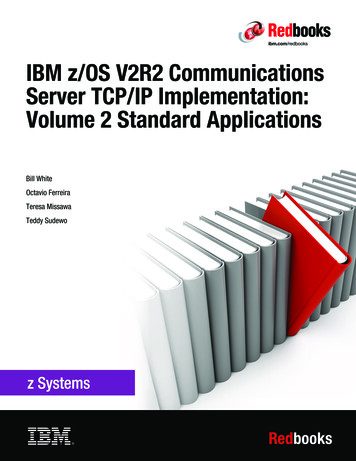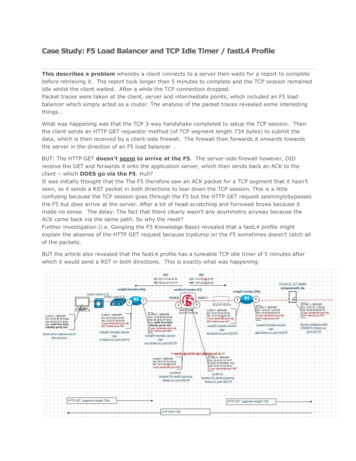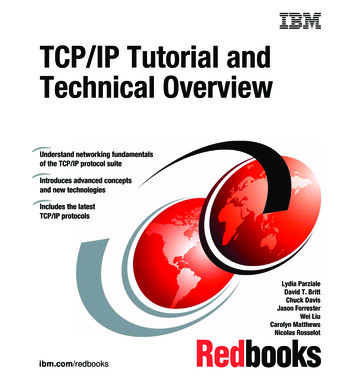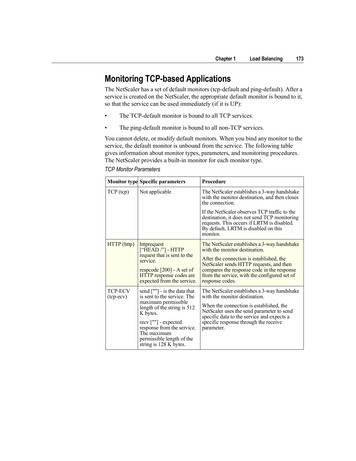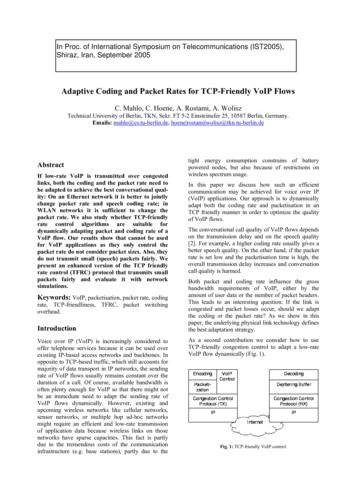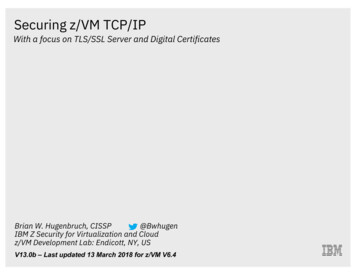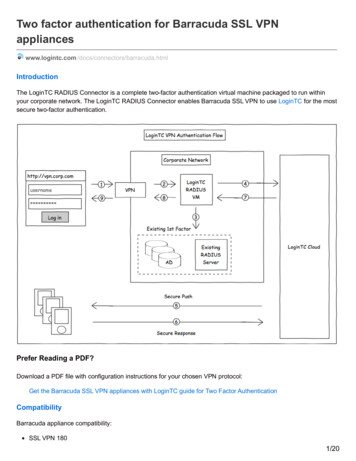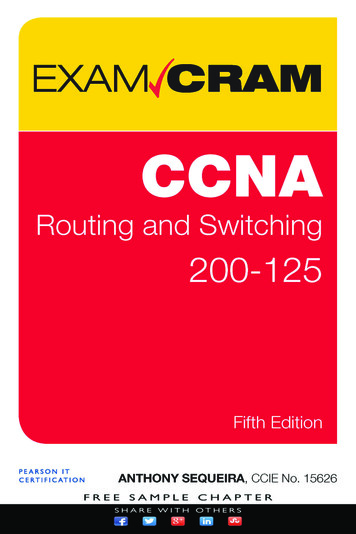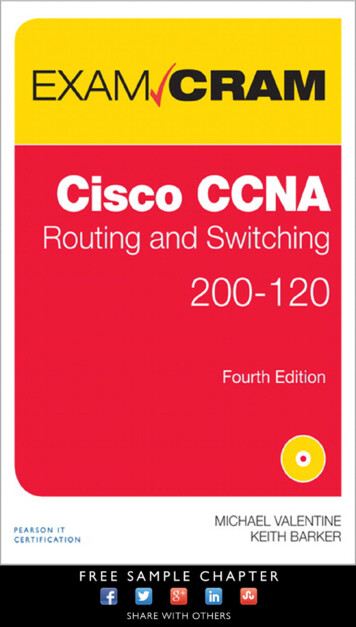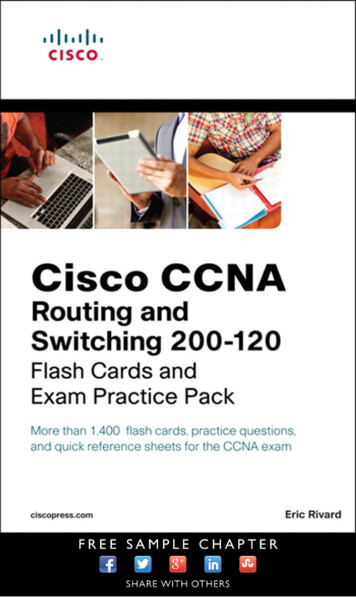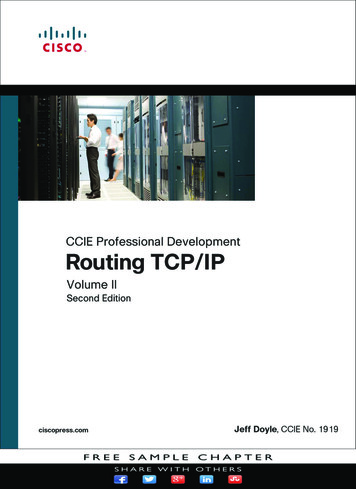
Transcription
Routing TCP/IP, Volume IICCIE Professional Development, Second EditionJeff DoyleCisco Press800 East 96th StreetIndianapolis, IN 46240
iiRouting TCP/IP, Volume IIRouting TCP/IP, Volume IICCIE Professional Development, Second EditionJeff DoyleCopyright 2017 Cisco Systems, Inc.Published by:Cisco Press800 East 96th StreetIndianapolis, IN 46240 USAAll rights reserved. No part of this book may be reproduced or transmitted in any form or by anymeans, electronic or mechanical, including photocopying, recording, or by any information storage and retrieval system, without written permission from the publisher, except for the inclusion ofbrief quotations in a review.Printed in the United States of AmericaFirst Printing August 2016Library of Congress Control Number: 2016936742ISBN-13: 978-1-58705-470-9ISBN-10: 1-58705-470-1Warning and DisclaimerThis book is designed to provide information about routing TCP/IP. Every effort has been made tomake this book as complete and as accurate as possible, but no warranty or fitness is implied.The information is provided on an “as is” basis. The authors, Cisco Press, and Cisco Systems, Inc.shall have neither liability nor responsibility to any person or entity with respect to any loss or damages arising from the information contained in this book or from the use of the discs or programsthat may accompany it.The opinions expressed in this book belong to the author and are not necessarily those of CiscoSystems, Inc.Trademark AcknowledgmentsAll terms mentioned in this book that are known to be trademarks or service marks have beenappropriately capitalized. Cisco Press or Cisco Systems, Inc., cannot attest to the accuracy of thisinformation. Use of a term in this book should not be regarded as affecting the validity of anytrademark or service mark.Special SalesFor information about buying this title in bulk quantities, or for special sales opportunities (whichmay include electronic versions; custom cover designs; and content particular to your business,training goals, marketing focus, or branding interests), please contact our corporate sales department at corpsales@pearsoned.com or (800) 382-3419.For government sales inquiries, please contact governmentsales@pearsoned.com.For questions about sales outside the U.S., please contact intlcs@pearson.com.
iiiFeedback InformationAt Cisco Press, our goal is to create in-depth technical books of the highest quality and value. Eachbook is crafted with care and precision, undergoing rigorous development that involves the uniqueexpertise of members from the professional technical community.Readers’ feedback is a natural continuation of this process. If you have any comments regardinghow we could improve the quality of this book, or otherwise alter it to better suit your needs, youcan contact us through email at feedback@ciscopress.com. Please make sure to include the booktitle and ISBN in your message.We greatly appreciate your assistance.Editor-in-Chief: Mark TaubProduct Line Manager: Brett BartowAlliances Manager, Cisco Press: Ron FliggeManaging Editor: Sandra SchroederDevelopment Editor: Christopher ClevelandProject Editor: Deadline Driven PublishingCopy Editor: Deadline Driven PublishingTechnical Editors: Darien Hirotsu, Pete MoyerEditorial Assistant: Vanessa EvansCover Designer: Chuti PrasertsithComposition: Patricia RatcliffIndexer: Angie MartinProofreader: Deadline Driven Publishing
ivRouting TCP/IP, Volume IIAbout the AuthorJeff Doyle, CCIE No. 1919, is vice president of research at Fishtech Labs. Specializingin IP routing protocols, SDN/NFV, data center fabrics, MPLS, and IPv6, Jeff hasdesigned or assisted in the design of large-scale IP service provider and enterprise networks in 26 countries over 6 continents. He worked with early IPv6 adopters in Japan,China, and South Korea, and has advised service providers, government agencies, military contractors, equipment manufacturers, and large enterprises on best-practice IPv6deployment. He now advises large enterprises on evolving data center infrastructures,SDN, and SD-WAN.Jeff is the author of CCIE Professional Development: Routing TCP/IP, Volumes I andII and OSPF and IS-IS: Choosing an IGP for Large-Scale Networks; a co-author ofSoftware Defined Networking: Anatomy of OpenFlow; and an editor and contributing author of Juniper Networks Routers: The Complete Reference. He also writes forForbes and blogs for both Network World and Network Computing. Jeff is one of thefounders of the Rocky Mountain IPv6 Task Force, is an IPv6 Forum Fellow, and serveson the executive board of the Colorado chapter of the Internet Society (ISOC).Jeff lives in Westminster, Colorado, with his wife Sara and a Sheltie named Max, theForrest Gump of the dog world. Jeff and Sara count themselves especially fortunate thattheir four grown children and a growing herd of grandchildren all live within a few miles.About the Contributing AuthorsKhaled W. Abuelenain, CCIE No. 27401, is currently the consulting director forAcuative, a Cisco Certified Managed Services Master Partner, at the company’s EMEAoffice in Saudi Arabia. He is a certified double CCIE (R&S, SP), holds a B.Sc. degree inelectronics and communication engineering from Ain Shams University, Egypt, and isan IEEE member since 1997. Khaled has been designing, operating, or optimizing largescale networks for more than 14 years throughout the Middle East, typically for serviceproviders and mobile operators with multinational presence, banks, and governmentagencies. He has extensive experience in routing, BGP, MPLS, and IPv6. Khaled is also anexpert on data center technologies and network programmability, with a special interestin Python programming for SDN solutions. He is an active member of both the CloudComputing and SDN IEEE societies.Nicolas Michel, dual CCIE No. 29410 R/S and DC, is a network architect with 10 yearsof experience in several fields: routing switching, data center, and unified communications. Nicolas is a former Sergeant in the French Air Force and started to work as a network engineer during the time he was serving. He has worked on several NATO-relatedprojects.He decided to move to Switzerland in 2011, to work for the local leading networkingconsulting company.He was the principal UC architect for the UEFA EURO 2016 football tournament.
vNicolas is also an eager reader about emerging network technologies (SDN, Automation/Network programmability). He blogs at http://vpackets.net and is also a president for anongovernmental organization that helps children with autism.He participates in an open source network simulation project: http://www.unetlab.com/.Nicolas is actually trying to relocate to the United States.From Nicolas: I would like to dedicate the work I have done on this book to my wonderful wife who has supported me throughout my career and helps me become a betterengineer and a better man. I wouldn’t be the same man without her.Also I would like to dedicate this work to my kids and my parents, who taught me tonever give up and to enjoy every moment.Finally, I would express my heartfelt thanks to Jeff Doyle for giving me the opportunityto work on this project. I learned so many things and I still can’t believe how lucky I was.About the Technical ReviewersDarien Hirotsu is a networking professional who has been in the industry for nearly adecade working on service provider, data center, and enterprise networks. He earned amaster’s degree in network engineering from UC Santa Cruz and a bachelor’s degree inelectrical engineering from Cal Poly San Luis Obispo. He also holds multiple expert levelcertifications, and is equally passionate about both the software and networking partsof SDN.Darien would like to send extra special thanks to his fiancé Rebecca Nguyen. Editing thisbook was both rewarding and time consuming. During the whole process and throughthe long weekends, Rebecca’s love, support, and patience never wavered, and for that, hewill always be grateful. Thank you for everything you do, Rebecca!Pete Moyer is an old-timer IP/MPLS consulting engineer who has turned his focustoward SDN in recent years. He has multivendor experience in IP networking, havingearned the first awarded JNCIE in the early 2000s and his CCIE in the late 1990s. Heis a co-author and technical editor of several networking books on IP and SDN andhas authored many articles and blogs on various networking topics. His current focusis on large-scale data center and service provider networks, including the Research& Education Network (REN) market. He also holds a B.S. degree in CMIS from theUniversity of Maryland.
viRouting TCP/IP, Volume IIDedicationsThis book is dedicated to my wife Sara; my children, Anna, Carol, James, andKatherine; and my grandchildren, Claire, Caroline, and Sam. They are my refuge, andthey keep me sane, humble, and happy.
viiAcknowledgmentsAn author of a technical book is just a front for a small army of brilliant, dedicatedpeople. This book is no exception. At the risk of sounding like I’m making an AcademyAward acceptance speech, I would like to thank a number of those people.I would like to thank Khaled Abu El Enian and Nicolas Michel, who contributed manynew end-of-chapter configuration and troubleshooting exercises. Khaled also helped meout in a time crunch and wrote most sections in “Scaling BGP Functions” in Chapter 5,“Scaling BGP.” I hope we can collaborate even closer on a future book or two.I would also like to thank Pete Moyer, my longtime friend and associate, who has been atechnical reviewer for every book I’ve written alone and has been a co-author on severalother books. Pete has had a profound influence on my life beyond this and other bookprojects, and I will always be indebted to him.Darien Hirotsu is the other technical reviewer on this book, and it’s the first time wehave worked together on a book project, although we have been associates across multiple companies and engineering projects. Darien is astoundingly detail-oriented andcaught countless tiny errors throughout my manuscript.My gratitude goes to Chris Cleveland for his expert guidance as development editor.We have collaborated on multiple books, and he has made each one a better book andme a better writer.Thanks to Brett Bartow and all the folks at Cisco Press. Brett has shown superhumanpatience with me as the book schedule constantly fell victim to “day job” priorities. Hehas continued to show me great kindness throughout the project when I’m sure he wouldhave preferred to bash me on the head with a copy of Volume I.I would like to thank my wife Sara, who has lived with me juggling multiple writing projects over many years. She long ago learned what it means when she notices me staringblankly at nothing, and says, “You’re writing in your head again, aren’t you?”Finally, I would like to thank you, good reader, for making the two volumes of RoutingTCP/IP such a success and for waiting so patiently for me to finish this new edition. Ihope the book proves to be worth your wait.
viiiRouting TCP/IP, Volume IIContents at a GlanceIntroductionxxiChapter 1Inter-Domain Routing Concepts 1Chapter 2Introduction to BGP 71Chapter 3BGP and NLRI 155Chapter 4BGP and Routing Policies 237Chapter 5Scaling BGP 401Chapter 6Multiprotocol BGP 615Chapter 7Introduction to IP Multicast Routing 713Chapter 8Protocol Independent Multicast 771Chapter 9Scaling IP Multicast Routing 881Chapter 10IPv4 to IPv4 Network Address Translation (NAT44) 931Chapter 11IPv6 to IPv4 Network Address Translation (NAT64) 995Appendix AAnswers to Review Questions 1047Index1079Appendix B (online) Answers to Configuration ExercisesAppendix C (online) Answers to Troubleshooting Exercises
ixContentsIntroduction xxiChapter 1Inter-Domain Routing Concepts1Early Inter-Domain Routing: The Exterior Gateway Protocol (EGP) 1Origins of EGP 2Operation of EGP 3EGP Topology Issues 3EGP Functions 5Neighbor Acquisition Protocol 6Neighbor Reachability Protocol 8Network Reachability Protocol 10Shortcomings of EGP 15The Advent of BGP 16BGP Basics 17Autonomous System Types 21External and Internal BGP 22Multihoming29Transit AS Multihoming 30Stub AS Multihoming 31Multihoming and Routing Policies 36Multihoming Issues: Load Sharing and Load Balancing 36Multihoming Issues: Traffic Control 37Multihoming Issues: Provider-Assigned Addressing 40Classless Inter-Domain Routing 41A Summarization Summary 41Classless Routing 43Summarization: The Good, the Bad, and the Asymmetric 47CIDR: Reducing Class B Address Space Depletion 50CIDR: Reducing Routing Table Explosion 50Managing and Assigning IPv4 Address Blocks 54CIDR Issues: Multihoming and Provider-Assigned Addresses 56CIDR Issues: Address Portability 58CIDR Issues: Provider-Independent Addresses 59CIDR Issues: Traffic Engineering 60CIDR Approaches Its Limits 62
xRouting TCP/IP, Volume IIIPv6 Comes of Age 66Routing Table Explosion, Again 66Looking Ahead 68Review Questions 69Chapter 2Introduction to BGP 71Who Needs BGP? 71Connecting to Untrusted Domains 71Connecting to Multiple External Neighbors 74Setting Routing Policy 79BGP Hazards 82Operation of BGP 84BGP Message Types 85Open Message85Keepalive MessageUpdate Message8686Notification Message87BGP Finite State Machine 87Idle State88Connect StateActive State8989OpenSent State89OpenConfirm State 90Established State 90Path Attributes90ORIGIN Attribute92AS PATH Attribute92NEXT HOP AttributeWeight97100BGP Decision Process 100BGP Message Formats 103Open Message 104Update Message 105Keepalive Message 108Notification Message 108
xiConfiguring and Troubleshooting BGP Peering 110Case Study: EBGP Peering 110Case Study: EBGP Peering over IPv6 114Case Study: IBGP Peering 118Case Study: Connected Check and EBGP Multihop 127Case Study: Managing and Securing BGP Connections 136Looking Ahead 142Review Questions 143Configuration Exercises 144Troubleshooting Exercises 145Chapter 3BGP and NLRI 155Configuring and Troubleshooting NLRI in BGP 155
iv Routing TCP/IP, Volume II About the Author Jeff Doyle, CCIE No. 1919, is vice president of research at Fishtech Labs.Specializing in IP routing protocols, SDN/NFV, data center fabrics, MPLS, and IPv6, Jeff
